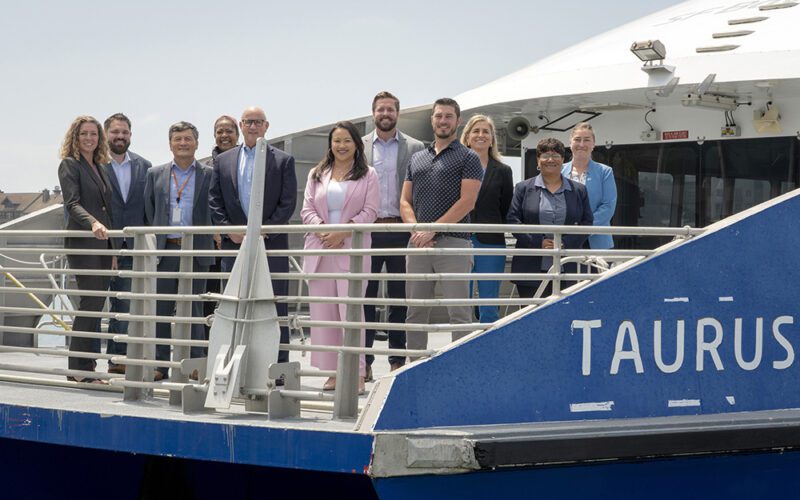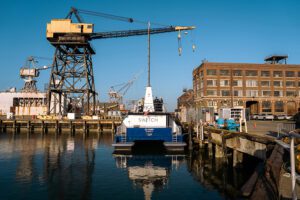
There’s been a lot of work recently that has kept West Coast ferry operators busy, including refits, new terminals, additional amenities and new infrastructure, as well as plans for cutting emissions.
Some developments are innovative and forward-looking, some are focused on passenger needs, while other projects are investing in strengthening and supporting the ferry service. To find out about the latest news and projects, Pacific Maritime reached out to a number of West Coast ferry operators.
Some notable updates include the successful fueling and sea trials of the world’s first commercial hydrogen fuel cell passenger ferry; selection of the design route for a fully electric passenger-only ferry project; a new terminal, added service and passenger amenities and a rebound in ridership for a Seattle-based ferry; the christening of a long-awaited addition to an Alaskan fleet; a fleet-wide engine repower project, and an unexpected extension on a repair project.
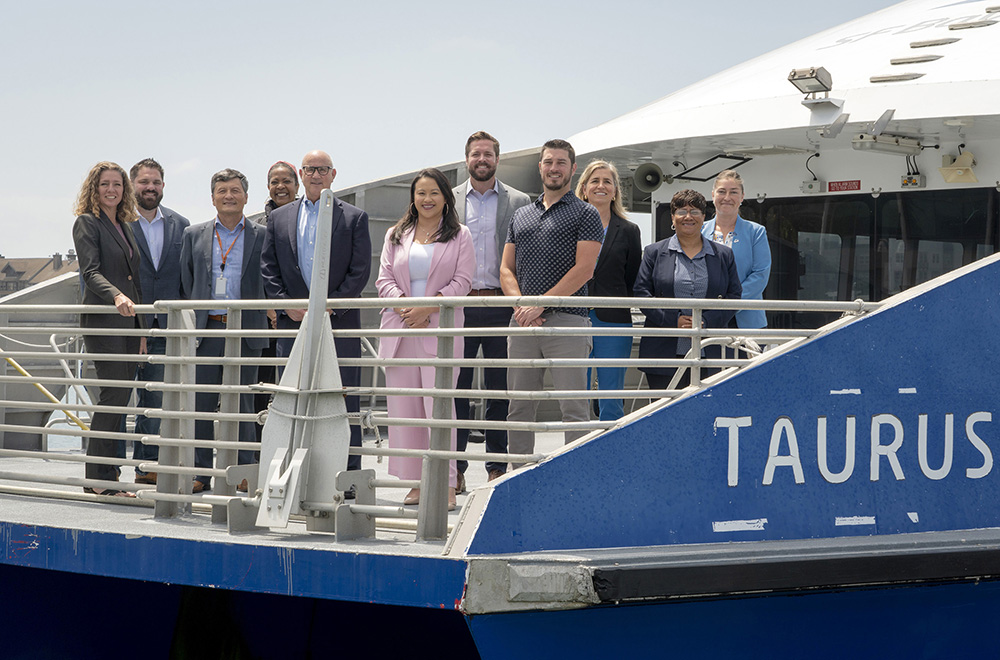
SF Bay Ferry
The world’s first commercial hydrogen fuel cell passenger ferry, the m/v Sea Change, has been going through rigorous sea trials as it prepares for a six-month pilot service slated to begin in August.
The San Francisco Bay Area Water Emergency Transportation Authority (WETA, but commonly known as San Francisco Bay Ferry) has said that the vessel was successfully fueled on June 22. The fueling milestone marked a significant step toward demonstrating hydrogen-based technology in the passenger ferry industry, officials noted in the announcement. After being fueled, the Sea Change is not producing any emissions other than water vapor.
“We all know that the Bay Area is home to the world’s most groundbreaking innovations, and this is another one for that list,” WETA Board of Directors Chair Jim Wunderman said in a prepared statement. “The Sea Change is not only a first-of-its-kind passenger ferry, but this pilot project will provide new and necessary insights into expanding hydrogen fuel cell technology in the maritime space.”
Already among the cleanest ferry systems in the U.S., WETA plans to shift 50% of its fleet to zero emissions by 2035. The Sea Change Hydrogen Ferry Demonstration Project is a public-private partnership designed to explore the viability of hydrogen technology as part of a high-speed passenger ferry system.
The project is backed by the Golden State Warriors NBA team, the Golden Gate Bridge Highway and Transportation District and other funding partners that are to be announced as the vessel prepares to carry thousands of riders during the pilot program.
“We believe that cutting-edge, sustainable technologies and initiatives, such as the Hydrogen Ferry are crucial for building a greener, more resilient Bay Area,” Warriors President and Chief Operating Officer Brandon Schneider said in a statement. “Together, we have the opportunity to showcase the transformative power of hydrogen fuel cells and continue to establish San Francisco as a global leader in clean transportation.”
Sea Change is a 70-foot, 75-passenger ferry built at All American Marine in Bellingham, Wash. The hydrogen fuel cell commercial ferry was created after Bay Area-based Zero Emission Industries won a grant from the California Air Resources Board to develop the project. The vessel is owned by Switch Maritime and is being leased for the duration of this demonstration project.
Once in operation, the ferry could carry passengers between Pier 41 on the city’s northern waterfront and the Downtown San Francisco Ferry Terminal.
WETA, along with the Bay Area Air Quality Management District, on May 23 hailed the completion of a Clean Air Conversion Project for the agency’s four Gemini-class vessels. The result is a substantial decrease in air pollution emissions from four San Francisco Bay ferries serving Oakland, Alameda and Richmond.
The vessels were initially built with tier 2 engines about 15 years ago. A $5.5 million project to upgrade the engines to tier 4 certified engines was approved by the board of directors in September 2021. Funding came from the Air District’s Carl Moyer grant program and proceeds from the Alameda County Transportation Commission’s sales tax Measure BB. The work was done at JT Marine in Vancouver, Wash.
According to officials, WETA has raised nearly $100 million for the operation of zero-emission ferry service in the U.S. Those funds support construction of five small battery-electric ferries to serve Alameda, Oakland and San Francisco’s waterfront neighborhoods, including the downtown core, Treasure Island and Mission Bay. Construction of the zero-emission vessels is expected to begin later this year.
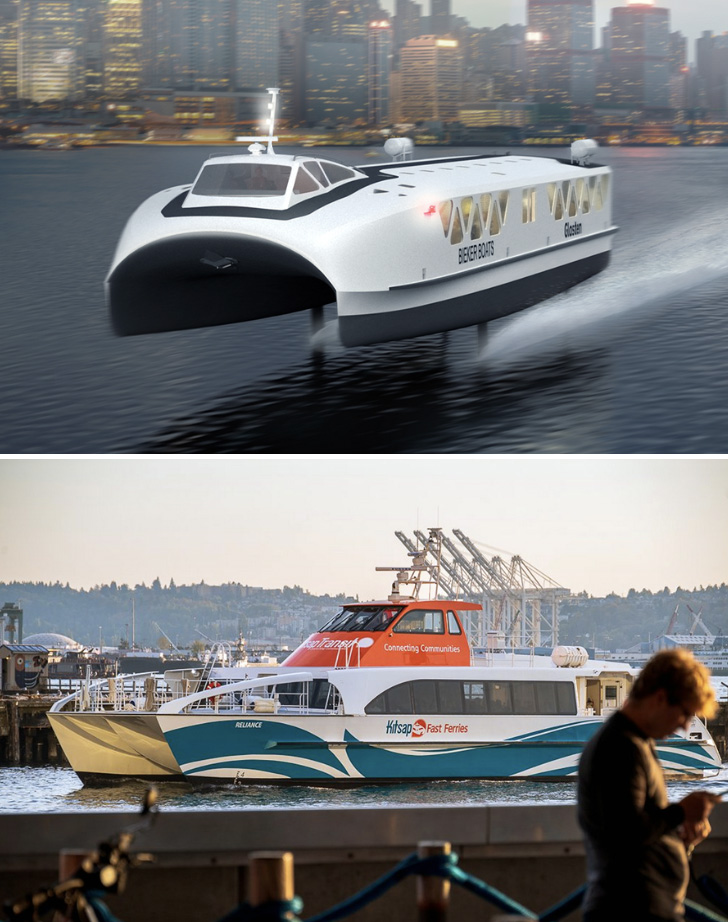
Photo courtesy of Fast Foil Ferry, LLC. (Above) Kitsap Transit’s Bremerton-Seattle route was selected as the design route for a fully electric passenger-only ferry project. Photo courtesy of Kitsap Transit.
Kitsap Transit
Another notable environmental-focused announcement comes as Kitsap Transit revealed in January 2022 that its Bremerton-Seattle route was selected as the design route for a fully electric passenger-only ferry. This essentially means that the vessel, carrying about 150 passengers according to preliminary plans, would be designed to complete a full round trip through Rich Passage on a single battery charge.
In 2020, KT and its partners, Foil Ferry, LLC and Washington Maritime Blue, were awarded a Federal Transit Administration innovation grant to complete a proof-of-concept report for a high-speed electric passenger ferry. The goal was to deliver a preliminary design, plus a business plan with studies covering route viability, shoreside infrastructure requirements, permitting requirements and economic and environmental impacts.
In early 2022, after the route was selected, the team applied for a grant that would potentially pay for the full design of the conceptual vessel.
“We still have a lot of work to do in this conceptual phase, including researching battery size, shore-side infrastructure needs and what it would take to charge the vessel at the Bremerton dock,” officials explained in the announcement.
The new vessel would significantly cut down on the emissions produced during the popular passage, which happens frequently as the Bremerton-Seattle route has the highest ridership of Kitsap Transit’s three fast-ferry routes. Current ferries cross the wake-sensitive Rich Passage and the Puget Sound in 30 minutes, according to the company.
“If we can virtually eliminate our fast ferries’ fossil-fuel emissions and their wake with an all-electric fast foil ferry, that’s a game-changer for marine transportation in the Puget Sound and progress toward a climate-friendly economy,” Kitsap Transit Executive Director John Clauson said in a statement.
In a Feb. 10 press conference with Senator Patty Murray (D-Wash.), Clauson highlighted some of the key benefits of the project.
“Zero emissions fast foil ferries could have a huge impact on this route in several ways,” he said. “One, we can dramatically reduce our greenhouse gas emissions; two, electric vehicles are generally a lot quieter than diesel ones, so we expect the ferry would have environmental benefits to the marine life in the Puget Sound, and three, a fast foil ferry would be moving across the water with less of its hull in the water and currently reducing the wake potential impacts through Rich Passage.”
Preliminary plans call for a modern carbon fiber hydrofoil design, which would allow the ferry to travel faster than diesel ferries with a dramatically lower carbon footprint. The current concept also includes bicycle storage inside the cabin.
The ferry is being designed by Anacortes-based Bieker Boats and Seattle naval architecture firm Glosten, collectively known as Foil Ferry, LLC.
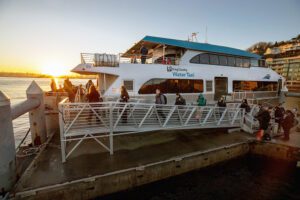
King County Water Taxi
As network and ridership demand for passenger ferry service around Seattle continues to grow, the King County (KC) Water Taxi is also evolving. The fast ferry service operated by the marine division of the King County Metro Transit Department covers two routes shuttling passengers between Downtown and either West Seattle or Vashon Island.
Since KC Water Taxi began operating out of a new passenger ferry terminal at Pier 50 in late 2019, it has become part of a larger transportation hub, spokesperson Al Sanders explained to Pacific Maritime.
The total cost of the project was about $45 million, which includes the new building and the new float for boats to dock. About 80% of the funding came from a grant from the FTA.
The new fully-covered facility, which features improvements to comply with the Americans with Disabilities Act, and expanded space for a capacity of up to 500 people, is also used by Kitsap Transit for its Fast Ferry service.
“The strong partnerships we have with Washington State Ferries and Kitsap Transit are a vital part of the regional transportation system,” Sanders said. “Through our multi-agency collaboration and strong relationships, all of us have been able to work together to provide the best service possible as we continue to recover.”
The relationships also could prove critical as all three agencies move forward with their zero-emissions initiatives, he added.
Sanders said King County Metro has a goal of being a zero-emissions transit provider by 2035.
“We are currently exploring the use of a variety of different alternative energy sources to power the new vessels and the associated shoreside infrastructure that will be needed,” he noted.
They’re in the final stages of a feasibility study for the marine division, and the team is evaluating multiple different propulsion systems and vessel designs that best meet their operational profile, Sanders said.
“This is a challenging effort with a lot of questions, but we are committed to using the best technology approved that guarantees the service reliability our customers depend on,” Sanders noted. “While there might be some challenges, we are excited to find ways to limit our emissions.”
KC Water Taxi also started providing midday service seven days a week in the fall of 2021 and winter of 2022 during the closure and repair of the West Seattle High Bridge. The ferry system saw enough service to continue with the seven-day midday sailings in the fall of 2022 through last winter.
Services and amenities also have expanded in recent years. Big tire bicycles (including many e-bikes) have become more popular, but the size of the tires prevented riders from boarding the Water Taxi as all bikes must be securely stowed for safety reasons.
Staff worked with bicycle storage experts Sportworks to find a solution. The team designed racks that that would fit both standard and “fat” tire sizes (as wide as 4.6 inches); they were installed in September 2021 on the m/v Doc Maynard and m/v Sally Fox. Each rack holds nine fat tire bikes and has an overall capacity of 26 bikes, regardless of tire width.
In January 2022, KC Water Taxi also welcomed furry, four-legged passengers onto its vessels—well-behaved dogs on leashes and cats in enclosed carriers.
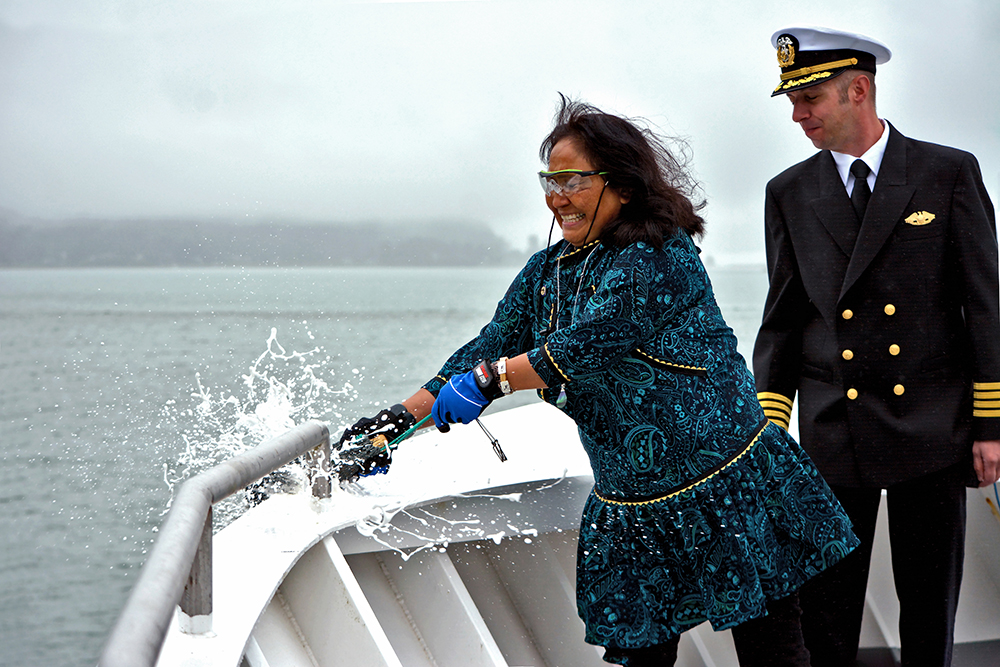
Alaska Marine Highway System
The biggest ferry-related recent news out of the Alaska Marine Highway System (AMHS) is the christening of the m/v Hubbard on June 26 as Alaska’s First Lady, Rose Dunleavy, smashed a ceremonial bottle of champagne on the bow of the ship. The ceremony celebrated the ship’s first season in service to Alaskans.
Utilizing the vessel in Lynn Canal allows AMHS to leverage the m/v LeConte, increasing service frequency for other communities in the Northern Panhandle. Hubbard started sailing this summer with about 60 passengers and 21 vehicles.
“We have an excellent, dedicated crew on the Hubbard,” Communication Director Shannon McCarthy said in an email to Pacific Maritime. “They are sailing one of our most popular routes, between Juneau, Haines and Skagway, six days a week, which has enabled Alaskans and visitors to get to where they need to go quickly and easily.”
A $15-million project adding crew quarters was completed last year, which enabled AMHS to schedule the ship for longer voyages and reach more ports. Plans added eight single-person staterooms on the bridge deck and eight two-person staterooms on the upper deck.
Upgrades also included installing a galley, scullery and mess spaces on the upper deck, and on the bridge deck a new fan room and extension of the existing port stair tower.
“Revitalizing the fleet is important to the long-term health of the Marine Highway, and the communities it serves,” Gov. Mike Dunleavy said in a prepared statement. “I’m pleased we’ve taken another step toward that.”
The U.S. Coast Guard granted the Hubbard its certificate of inspection in May, which allowed the vessel to commence revenue service, beginning its first operational year since it was delivered in 2019. The ship entered service for the first time on May 23 of this year.
The Alaska Marine Highway System is also working on an overhaul project for the m/v Matanuska, which needed safety upgrades and repairs. Work began on Matanuska in November 2022, when crews uncovered additional wasted steel and hazardous materials, both of which required additional time for removal and repair in the shipyard.
Due to the extra time and expense, AMHS and the Alaska Dept. of Transportation and Public Facilities considered an extended overhaul to address the steel and abatement issues in addition to egress issues in the Matanuska’s original design, including revising dead-end corridors and upgrading the ship’s fire and smoke detection systems. As of late June, the Matanuska was still laid up due to the much-needed repairs. M/V Columbia covered Southeast Alaska and Bellingham routes for the out-of-service ship during the project.
Overseeing nine ferries along 3,500 marine miles, the Alaska Department of Transportation and Public Facilities also has been investing in shoreside infrastructure.
Potentially adding to that, the department and Goldbelt, Inc. signed a contract on March 9 to study the feasibility of a possible Alaska Marine Highway ferry terminal at Cascade Point, which would increase sailings in the Northern Lynn Canal. The agreement is to work cooperatively on feasibility studies, engineering evaluations, cost estimates environmental permitting for the potential site, just north of Juneau, Alaska.
“This is about supporting the economy of Southeast Alaska—and making travel for Alaskans more efficient and more affordable,” Dunleavy said in a statement.
According to an October 2020 report from an AMHS work group, a terminal at that location would reduce Juneau-Haines and Juneau-Skagway one-way sailing by about 30 miles, or 2.1 hours. The reduced time and more frequent sailings would result in decreased costs per trip and would enable AMHS to pass savings along to passengers through fare reductions.
The North Lynn Canal route is historically AMHS’s second-largest volume run. According to officials, residents and elected leaders of the area have frequently expressed the need for additional sailings.
A conceptual site plan includes an unmanned day-use terminal, single-end loading ferry berth and 50-foot Cascade Creek Bridge, leading to a staging and parking area. The terminal building would include a generator shed, pit-style restrooms, including ancillary support infrastructure such as a 10,000-gallon sewage holding tank, 5,000-gallon fuel storage tank, electrical generation and potable water. Cost for the Cascade Point Ferry Terminal is currently estimated at $36 million.
Catalina Express
Catalina Express, a family-owned business offering up to 30 roundtrips daily to/from Catalina Island, Calif., recently wrapped up a fleet-wide engine repower project with Marine Group Boat Works, a boat repair and construction facility based near San Diego.
The project began in 2022 with the high-speed catamaran Catalina Jet, MGBW Director of Business Development Tim Cooper explained to Pacific Maritime. The Caterpillar engines were repowered to tier 3 engines to fully comply with California Air Resources Board’s impending regulations.
Along with the engine repower, the project included a full high pressure water blast with new topside paint, installation of a new NAIAD ride control system, renewing of shell plating, installation of new hydraulic lines among many other tasks.
The remaining four vessels underwent engine repowers in early 2023. The high-speed monohulls Catalina Express and Islander Express each received two new MTU tier 3 engine packages which included all new cabling and controls, Cooper said. The engines that were removed from the vessels had low engine hours and were reused for the repower of two other high-speed monohulls, Avalon Express and Super Express.
The vessels also underwent general maintenance including shaft work, ride-control component upgrades and rudder work. Three also received new paint.
Catalina Express, founded in 1981, has in recent years gone above and beyond environmental regulations to help preserve Southern California’s coastline, company representatives said in an email to Pacific Maritime. The company has worked closely with marine architects and engine manufacturers to develop vessels that reduce emissions.
“Each of the eight vessels has been re-engined to reduce nitrogen oxide emissions and updated to comply with the Environmental Protection Agency’s tier 2 or tier 3 regulations for emissions levels,” Catalina Express President and CEO Greg Bombard said in a statement.
In 2017, the Port of Los Angeles reported that Catalina Express had eliminated 800 tons of nitrogen oxide emissions, 30 tons of particulate matter emissions and 10,000 tons of greenhouse gas emissions—the equivalent of 10,000 cars.
In addition to the re-engine projects, the company has worked with their fuel provider California Fuel & Lubes to migrate a majority of the Catalina Express vessels to renewable diesel (R99), which is derived from a base of soybean oil and other vegetable stocks.
BC Ferries
BC Ferries had been down one ship as the Coastal Celebration refit project was extended due to complications with its propulsion systems. However, the Celebration returned to service on July 4 after completing repairs and successful sea trials. It was originally anticipated to return by June 15.
“While in dry dock, shipyard crews discovered an issue with the stern tube bearings and the rudder stock. Both are critical to the successful, efficient and safe operation of the vessel’s propulsion system,” officials explained in a statement. “The repair is complex and requires significant crew hours to execute and test.”
Despite the decrease of overall passenger and vehicle capacity, BC Ferries’ customer care team averted booking cancellations in the wake of the unplanned removal of the ship from service, officials noted on June 18. More than 6,600 bookings were reassigned to the company’s other ferries, the Spirit of Vancouver Island, Spirit of British Columbia and the Queen of New Westminster.

